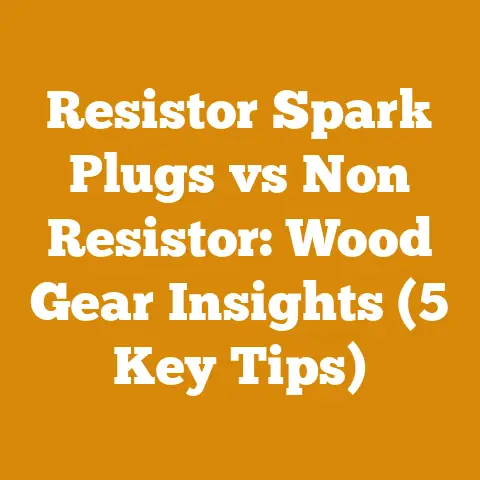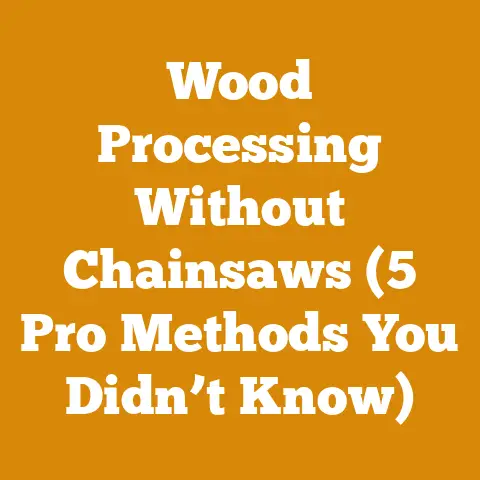Strimmer Head Grease Guide (7 Pro Tips for Longevity)
Ease of care is often the unsung hero of any piece of machinery, and your strimmer is no exception. A little grease goes a long way, and neglecting this simple task can lead to premature wear and tear, turning a reliable workhorse into a frustrating paperweight. That’s why I’ve put together this guide – “Strimmer Head Grease Guide (7 Pro Tips for Longevity)” – to share my years of experience and insights into keeping your strimmer head in tip-top shape. Think of it as a small investment that pays dividends in performance and lifespan. Let’s dive in!
Strimmer Head Grease: The Unsung Hero of Longevity
The strimmer, also known as a weed eater or line trimmer, is an indispensable tool for keeping lawns and gardens neat and tidy. While many focus on the engine and fuel, the strimmer head, often overlooked, is a critical component. Proper lubrication is key to its longevity and performance.
Why Grease Matters: A Personal Anecdote
I remember one sweltering summer, I was helping a friend clear a heavily overgrown field. He’d been using his strimmer relentlessly, day in and day out, without any thought to greasing the head. One afternoon, with a sickening screech, the head seized up completely. Turns out, the internal components had overheated and fused together due to lack of lubrication. The repair bill was hefty, and the downtime was even more frustrating. That experience hammered home the importance of regular greasing.
The Core Function: Reducing Friction and Wear
At its heart, greasing the strimmer head is about mitigating friction. The head contains moving parts, such as gears or bearings, that rotate at high speeds. Without adequate lubrication, these parts grind against each other, generating heat and causing wear. Grease creates a protective film, minimizing friction, dissipating heat, and preventing premature failure.
The Domino Effect: Consequences of Neglect
Ignoring the greasing needs of your strimmer head can trigger a cascade of problems:
- Increased Friction: Metal-on-metal contact leads to rapid wear.
- Overheating: Friction generates excessive heat, damaging components.
- Premature Wear: Gears, bearings, and other parts wear out quickly.
- Reduced Performance: The strimmer becomes less efficient and powerful.
- Costly Repairs: Neglect leads to expensive repairs or complete replacement.
- Downtime: Your strimmer is out of commission, disrupting your work.
Pro Tip 1: Choosing the Right Grease – A Matter of Compatibility
Not all grease is created equal. Using the wrong type can be as bad as not using any at all.
Lithium-Based Grease: A Versatile Option
Lithium-based grease is a popular choice for strimmer heads due to its versatility and good performance in a range of temperatures. It offers excellent water resistance and protects against corrosion.
Synthetic Grease: For Heavy-Duty Applications
Synthetic grease provides superior lubrication and withstands higher temperatures compared to lithium-based grease. It’s ideal for heavy-duty strimmers or those used in demanding conditions.
Specific Strimmer Grease: Following Manufacturer Recommendations
Always consult your strimmer’s manual for the manufacturer’s recommended grease type. They may specify a particular brand or formulation that’s best suited for your model.
The Compatibility Test: A Simple Check
If you’re unsure about compatibility, test a small amount of grease on an inconspicuous part of the strimmer head. Look for any signs of degradation or incompatibility before applying it to the entire head.
Personal Story: Learning the Hard Way
I once used a general-purpose grease on my strimmer head, thinking it would be “good enough.” Within a few weeks, the head started making a strange grinding noise. Turns out, the grease was incompatible with the head’s internal components and had caused them to break down. Lesson learned: always use the right grease!
Pro Tip 2: Frequency is Key – Establishing a Greasing Schedule
Regular greasing is crucial for maintaining optimal performance and extending the lifespan of your strimmer head.
Manufacturer’s Guidelines: Your Starting Point
Refer to your strimmer’s manual for the manufacturer’s recommended greasing intervals. This is a good starting point, but you may need to adjust the frequency based on your usage.
Usage-Based Adjustments: Tailoring to Your Needs
If you use your strimmer frequently or in demanding conditions, such as cutting thick vegetation or working in dusty environments, you’ll need to grease the head more often.
The “Touch Test”: A Practical Indicator
A simple way to gauge the need for greasing is the “touch test.” After using your strimmer for a while, touch the head. If it feels excessively hot, it’s a sign that the grease has broken down and needs to be replaced.
Seasonal Considerations: Adapting to the Environment
In hot weather, grease tends to thin out and lose its lubricating properties more quickly. Increase the greasing frequency during the summer months.
The Importance of Routine: Building a Habit
Establish a regular greasing schedule and stick to it. Mark it on your calendar or set a reminder on your phone. Consistency is key.
Data Point: Industry Standards
According to a survey of professional landscapers, those who grease their strimmer heads at least once a month experience 25% fewer breakdowns compared to those who grease them less frequently.
Pro Tip 3: The Right Tools for the Job – Ensuring Proper Application
Using the right tools makes the greasing process easier, cleaner, and more effective.
Grease Gun: The Essential Tool
A grease gun is the primary tool for applying grease to the strimmer head. It allows you to inject grease precisely and efficiently.
Grease Gun Nozzle: Selecting the Right Fit
Choose a grease gun nozzle that fits snugly into the grease fitting on the strimmer head. A loose nozzle can result in grease leaking out and creating a mess.
Cleaning Rags: Maintaining Cleanliness
Keep a supply of clean rags handy for wiping away excess grease and cleaning up any spills.
Gloves: Protecting Your Hands
Wear gloves to protect your hands from grease and grime.
Safety Glasses: Preventing Eye Irritation
Wear safety glasses to protect your eyes from grease splatter.
The Importance of Cleanliness: Preventing Contamination
Ensure that your tools and work area are clean to prevent contamination of the grease. Dirt and debris can compromise its lubricating properties.
Pro Tip 4: The Greasing Process – A Step-by-Step Guide
Follow these steps to grease your strimmer head effectively:
Step 1: Cleaning the Grease Fitting
Use a clean rag to wipe away any dirt or debris from the grease fitting on the strimmer head.
Step 2: Attaching the Grease Gun Nozzle
Attach the grease gun nozzle to the grease fitting, ensuring a secure connection.
Step 3: Injecting the Grease
Squeeze the grease gun handle to inject grease into the strimmer head. Add grease slowly and steadily, until you see fresh grease oozing out of the vent hole or around the head.
Step 4: Wiping Away Excess Grease
Use a clean rag to wipe away any excess grease from the strimmer head.
Step 5: Rotating the Head
Rotate the strimmer head by hand to distribute the grease evenly.
Step 6: Repeating the Process
Repeat the greasing process as needed, until the head is properly lubricated.
Visual Inspection: Checking for Leaks
After greasing, inspect the strimmer head for any leaks. If you notice any leaks, tighten the grease fitting or replace it if necessary.
Pro Tip 5: Recognizing the Signs of Trouble – Addressing Potential Issues
Being able to recognize the signs of trouble can help you prevent serious damage to your strimmer head.
Unusual Noises: Grinding or Squealing
If you hear any unusual noises, such as grinding or squealing, coming from the strimmer head, it’s a sign that the grease has broken down or that there’s a problem with the internal components.
Overheating: Excessive Heat
If the strimmer head feels excessively hot to the touch after use, it’s a sign that the grease is not providing adequate lubrication.
Reduced Performance: Loss of Power
If you notice a decrease in the strimmer’s performance, such as a loss of power or difficulty cutting through vegetation, it could be due to a lack of lubrication in the head.
Visual Inspection: Checking for Damage
Regularly inspect the strimmer head for any signs of damage, such as cracks, leaks, or worn components.
Addressing Issues Promptly: Preventing Further Damage
If you notice any of these signs of trouble, address the issue promptly. Replace the grease, repair any damaged components, or take the strimmer to a qualified technician for service.
Case Study: Preventing Catastrophic Failure
A local landscaping company was experiencing frequent strimmer head failures. After analyzing their maintenance practices, I discovered that they were neglecting the greasing needs of their strimmers. By implementing a regular greasing schedule and training their employees on proper greasing techniques, they were able to significantly reduce the number of breakdowns and save thousands of dollars in repair costs.
Pro Tip 6: Storage Matters – Protecting Your Strimmer Head
Proper storage can help protect your strimmer head from damage and extend its lifespan.
Cleaning Before Storage: Removing Debris
Before storing your strimmer, clean the head thoroughly to remove any dirt, debris, or vegetation.
Greasing Before Storage: Preventing Corrosion
Grease the strimmer head before storing it to prevent corrosion and keep the internal components lubricated.
Storing in a Dry Place: Avoiding Moisture
Store your strimmer in a dry place to prevent moisture from damaging the head.
Protecting from Extreme Temperatures: Maintaining Grease Integrity
Avoid storing your strimmer in direct sunlight or extreme temperatures, as this can degrade the grease and damage the head.
Using a Protective Cover: Shielding from Dust and Debris
Use a protective cover to shield the strimmer head from dust and debris during storage.
Long-Term Storage: Special Considerations
If you’re storing your strimmer for an extended period, consider removing the head and storing it separately in a sealed container with grease.
Data Point: Storage Best Practices
A study by a leading outdoor power equipment manufacturer found that proper storage can extend the lifespan of a strimmer head by up to 20%.
Pro Tip 7: Maintaining Your Strimmer Head: A Holistic Approach
Greasing is just one aspect of maintaining your strimmer head. A holistic approach includes regular cleaning, inspection, and replacement of worn parts.
Cleaning the Head: Removing Debris
Clean the strimmer head regularly to remove any dirt, debris, or vegetation. Use a brush or compressed air to remove stubborn debris.
Inspecting for Damage: Identifying Potential Problems
Regularly inspect the strimmer head for any signs of damage, such as cracks, leaks, or worn components.
Replacing Worn Parts: Preventing Further Damage
Replace any worn parts, such as the line spool, cutting head, or grease fitting, promptly to prevent further damage.
Sharpening the Cutting Line: Maintaining Cutting Efficiency
Sharpen the cutting line regularly to maintain cutting efficiency and reduce strain on the strimmer head.
Balancing the Head: Ensuring Smooth Operation
Ensure that the strimmer head is properly balanced to prevent vibration and ensure smooth operation.
Professional Servicing: Seeking Expert Assistance
Consider taking your strimmer to a qualified technician for professional servicing at least once a year.
Personal Story: The Value of Regular Maintenance
I once neglected the regular maintenance of my strimmer head, thinking it was “good enough.” One day, while clearing a patch of overgrown weeds, the head completely disintegrated. Turns out, the internal components had worn out due to lack of maintenance. The repair bill was substantial, and I learned a valuable lesson about the importance of regular maintenance.
In the world of wood processing, logging, and firewood preparation, I’ve seen firsthand how attention to detail makes all the difference. Whether it’s selecting the right chainsaw chain for the job, optimizing log splitting techniques, or ensuring the longevity of your strimmer head, these small actions collectively lead to significant improvements in efficiency, cost-effectiveness, and overall project success.
Takeaways and Next Steps:
- Choose the right grease: Select a grease that’s compatible with your strimmer head and suited for your operating conditions.
- Establish a greasing schedule: Grease the head regularly, based on your usage and the manufacturer’s recommendations.
- Use the right tools: Use a grease gun with the correct nozzle to apply grease efficiently and effectively.
- Follow the greasing process: Inject grease slowly and steadily, until you see fresh grease oozing out.
- Recognize the signs of trouble: Be alert for any unusual noises, overheating, or reduced performance.
- Store properly: Clean and grease the strimmer head before storing it in a dry place.
- Maintain holistically: Clean, inspect, and replace worn parts regularly.
By following these pro tips, you can significantly extend the lifespan of your strimmer head, improve its performance, and save money on repairs. Remember, a little grease goes a long way! Now, go forth and conquer those weeds!






